BRIEFING MATERIALS:
A full audio recording of the briefing with annotated timestamps can be found here
To view the presentation slides used in the briefing, please click 07.24.17-ACCRC-Briefing-Presentation-Slides.pdf">here.
A Congressional briefing co-hosted by the Northeast-Midwest Institute and the Asian Carp Regional Coordinating Committee (ACRCC) addressed the recent discovery of an invasive Asian carp in the Chicago Area Waterway System (CAWS) and the ACRCC’s Contingency Response outlined in their 2017 Carp Monitoring Plan . The speakers at the briefing gave background on the discover that triggered the Contingency Response, the results of intensive two-week sampling required by the Carp Monitoring and Response Plan, and plans for further sampling in 2017. The twenty-eight inch adult Silver Asian carp which triggered the Contingency Response was captured nine miles from Lake Michigan just before the TJ O’Brien Lock and Dam on the Calumet River on June 22.
Mr. Charlie Wooley of the U.S. Fish and Wildlife Service and Mr. Kevin Irons of the Illinois Department of Natural Resources reported that no additional silver or bighead Asian carp were found in the CAWS. They went on to describe the process the ACRCC went through to come that conclusion, including eDNA sampling, electrocuting, and net fishing runs resulting in the capture of 20,665 fish between June 26 and July 7. Ultimately, Mr. Wooley and Mr. Irons concluded that there was no reason to believe that more silver or bighead Asian Carp had reached Lake Michigan or even gone beyond the electric dispersal barrier. Nevertheless, the June carp finding will result in a more intensive sampling process during the ACRCC’s biannual two-week Seasonal Intensive Monitoring Even in September. Additionally, eDNA sampling of CAWS water will take place in advance of the Monitoring Event, though the results of those samples will not trigger further response actions. Further plans for intensive monitoring are subject to the findings of a team of biologists at Southern Illinois University working to deduce the age, origin, and fertility of the silver Asian carp.
The briefing allowed state and federal officials the opportunity to provide details in-person to Congressional staff on the actions that the ACRCC have taken to detect potential additional Asian carp in the Great Lakes basin. In addition to presentations by the U.S. Fish and Wildlife Service and the Illinois Department of Natural Resources, representatives of the U.S. Environmental Protection Agency and the U.S. Army Corps of Engineers were present to answer additional questions after the briefing.
This briefing was co-hosted by the Great Lakes Washington Program (GLWP) at the Northeast-Midwest Institute. Created to further the restoration and revitalization of the region, the GLWP improves the Great Lakes ecosystem and economy through its relationship with the bipartisan U.S. Senate and House Great Lakes Task Forces of the Northeast-Midwest Coalitions, as well as its outreach and interaction with state, provincial, and federal agencies, experts, and stakeholders. By conducting and providing non-partisan federal policy research and background, and tracking legislation, the GLWP serves as a trusted source for the region on Great Lakes issues. You can read more about the GLWP here.


